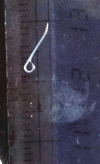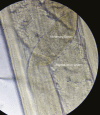Human Thelaziasis: Emerging Ocular Pathogen in Nepal
- PMID: 30349847
- PMCID: PMC6189630
- DOI: 10.1093/ofid/ofy237
Human Thelaziasis: Emerging Ocular Pathogen in Nepal
Abstract
Thelaziasis is an ocular arthropod-borne, zoonotic disease of the eye infecting the conjunctival sac, lacrimal duct, and lacrimal gland caused by a nematode of the genus Thelazia. We report the first case of human ocular thelaziasis in Nepal in a 6-month-old child from a Rukum district, Nepal. The infant presented with conjunctivitis, and his visual acuity and dilated fundal examination were normal. A total of 6 worms were removed for identification. Collected nematodes were identified based on morphological keys as Thelazia callipaeda. The patient's symptoms improved after removal of the nematodes.
Keywords: Nepal; Phortica variegata; Thelazia callipaeda; Thelaziasis; zoonotic disease.
Figures








References
LinkOut - more resources
Full Text Sources

